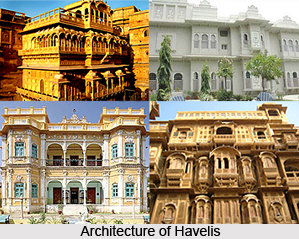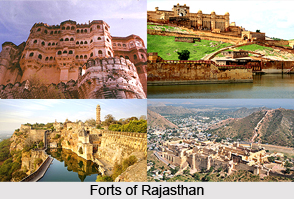 Architecture of Rajasthan mainly encompasses the Rajput school of architecture which was a blend of the Hindu and the Mughal structural design. Rajasthan is the store house of some of the magnificent forts and palaces of the worlds. The splendid forts, intricately carved temples and ornamented havelis are part of the architectural heritage of Rajasthan. The Rajputs were creative builders and the major architectural creations are positioned in the cities like Udaipur, Jaisalmer, Jodhpur and Jaipur. The renowned architectural specimens of Rajasthan include Dilwara Temples, Jantar Mantar, Lake Palace Hotel, Chittorgarh Fort, City Palaces, and Jaisalmer Havelis.
Architecture of Rajasthan mainly encompasses the Rajput school of architecture which was a blend of the Hindu and the Mughal structural design. Rajasthan is the store house of some of the magnificent forts and palaces of the worlds. The splendid forts, intricately carved temples and ornamented havelis are part of the architectural heritage of Rajasthan. The Rajputs were creative builders and the major architectural creations are positioned in the cities like Udaipur, Jaisalmer, Jodhpur and Jaipur. The renowned architectural specimens of Rajasthan include Dilwara Temples, Jantar Mantar, Lake Palace Hotel, Chittorgarh Fort, City Palaces, and Jaisalmer Havelis.
Rajasthan, the largest state in India is renowned for its historical monuments. Rajasthan was a major provincial capital of the Indus Valley Civilisation. Traditionally the Rajputs, Bhils, Jats, Yadavs, Gujjars and other tribes made a great contribution in building the state of Rajasthan. It was formerly known as Rajputana and was a princely state ruled by the Rajputs. Modern Rajasthan comprises a number of Rajput kingdoms, Jat kingdoms and a Mughal kingdom. The forts and palaces of Rajasthan are enriched by Muslim and Jain architecture. The structural design of Rajasthan is basically secular and draws a lot of motivation from the Mughals, while the later day architecture also embraces European interiors.
The prominent Rajput architecture of Rajasthan is the Deeg palace. Deeg Palace is surrounded by wide gardens which are inspired by the garden architecture of the Mughals. The palaces of Jaipur reflect a heavy influence of Islam. The palace is designed in the Islamic style and the spaces have all been given Islamic names for example the Hawa Mahal. The palace is designed along the lines of a traditional Rajasthan mansion, but different from the residential part of Mughal palaces. Chambers for residential, administrative and courtly functions are all contained within these multi-storied walls.
 The Jantar Mantar of Jaipur is an awe inspiring architectural monument.It has been built on the basis of the requirements of natural sciences and as a result has given a unique architectural marvel that is more at home in the modern era. On the northern outskirts of Jaipur there are the Royal Tombs including that of Maharaja Sawai Jai Singh II. Because of the Islamic influence, various Rajputs started building tombs, but since they were Hindus, they are all empty cenotaphs. The open umbrella type tombs are the specialty of this architecture.
The Jantar Mantar of Jaipur is an awe inspiring architectural monument.It has been built on the basis of the requirements of natural sciences and as a result has given a unique architectural marvel that is more at home in the modern era. On the northern outskirts of Jaipur there are the Royal Tombs including that of Maharaja Sawai Jai Singh II. Because of the Islamic influence, various Rajputs started building tombs, but since they were Hindus, they are all empty cenotaphs. The open umbrella type tombs are the specialty of this architecture.
Islamic influence in the architecture of Rajasthan is most prominent in the city of Ajmer. The important monuments of this city are the Dargah Sharif of Khwaja Muinuddin Chishti which consists of a number of white marble buildings arranged around two courtyards, including a huge gate donated by the Nizam of Hyderabad, a mosque given by Shah Jahan and the Akbari mosque. Hindu architecture can be witnessed in Pushkar where there are several Ghats and temples. The outstanding temples standing in an array, with their touches of the Islamic architectural style, are richly different in style.
During the British era, Rajputs became the vassals of the British and brought British influences into architecture, too. It is quite common to see buildings designed by British architects in Jaipur. The Rambag Palace for example, which is now a high class hotel is built in the Indo- Saracenic style. The Balsamad Lake palace of Jodhpur built in the 19th century is a summer palace built in the European style, with a garden in the Mughal style, facing a man-made lake.
Architecture of Rajasthan is a magnanimous array of Hindu, Islamic and colonial architecture. The rich architectural heritage of Rajasthan makes it one of the major tourist attractions of India.




